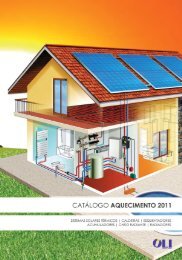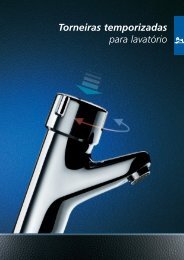Contents
Contents
Contents
You also want an ePaper? Increase the reach of your titles
YUMPU automatically turns print PDFs into web optimized ePapers that Google loves.
Sewage DisposalPlanning GuideUntreated sewage from buildings, as well as rainwater from roofs,courtyards or other catchment areas, that cannot be drained naturallyby gravity flow by means of the local sewer system must first belifted to a sufficiently high level by pump stations or lifting plantsbefore the fluid can be discharged into the sewer system. How thissewage is disposed of depends on the type of material handled.Wilo submersible pumps and sewage lifting plants have been specificallydesigned to meet these differing requirements. Wilo pumps andlifting plants all comply with applicable EN guidelines.Planning and design of wastewater and sewage disposal from buildingsand sites must be carried out in compliance with local drainageregulations and DIN EN 12050/12056, "Wastewater lifting plants forbuildings and sites." In this context, a distinction is made betweensewage disposal from outlets above the local backflow level, whichmust be discharged into the public sewage network by natural gravityflow, and sewage from outlets whose trap water levels are belowthe local backflow level. The backflow level is defined as at least thetop of the street gutter (kerb edge), but a higher level may be prescribedby the local authorities.Sewage (rain and wastewater) that collects below the backflow levelmust be discharged into the public sewage network by means ofautomatic lifting plants – Wilo sewage lifting plants or Wilo submersiblepumps.Calculating the required pump/plant capacityFlow rate Qp [l/s]:This capacity is the sum of the wastewater inflow Qs and rainwaterinflow Qr and must be measured in accordance with EN 12050/EN12056:Qs = Wastewater rate [l/s] is the sum of sewage from all fixtures withconsideration of simultaneity.Qr = Rainwater rate [l/s] is the product of rainwater collected, drainagefactor and the catchment area.Delivery head H tot [m]:This is the sum of the difference in height between the lowest collectortank level and the lowest point of the discharge pipe loop +the total pipe friction losses Hf [m] in the pressure line.Note: When selecting a lifting plant, note that the pressure differencebetween the delivery head at nominal flow rate (note minimumflow rate) and the delivery head at null flow rate must be approx.2-3 m at the operating point for the check valve body to open.For more information on planning:See the Wilo planning manual on "Sewage Disposal".Sewage DisposalPlanning GuideSpecific requirements that must be taken into account in the planningand construction of drainage systems in accordance withDIN 1986-100 EN 12050 regulations include the following:– Lifting plants must be designed to guarantee a minimum flowvelocity of 0.7 m/s with a pressure line of the specified nominaldiameter.Prescribed minimum nominal diameters:Wastewater lifting plant - DN 32Sewage lifting plant - DN 80 (without separator/macerator)– The pressure line of a lifting plant must be equipped with a checkvalve body and guided so that its lowest point is above the backflowlevel. The pressure line must not be connected to wastewaterdownpipes.– Wastewater gate valves must be fitted (inlet and discharge ends)in accordance with DIN 1986-100 and EN 12050/EN 12056 regulations.– Vent pipes from the lifting plant must be carried above roof level.The minimum pipe nominal diameter for sewage lifting plants isDN 70.– Feed lines must be laid with sufficient gradient (at least 1:50).– Pipelines through masonry should be laid flexibly.– An automatic standby pump must be provided if the sewage pipecannot cope with interrupted discharge.– Switchboxes and signal components must be installed in a dry andeasily accessible location; alarm components must be clearly visible.– Lifting plants must be regularly maintained.– Installation rooms must have adequate ventilation and lighting.A clearance of not less than 600 mm must be provided above andaround all control elements of the plant and parts which requiremaintenance.The lifting plant must firmly anchored to prevent buoyancy.– Sewage containing petroleum oils or hazardous substances mustbe disposed of via an oil or petrol trap, sewage containing fats via agrease trap and wastewater containing sand via a sand trap. Sewagecontaining acidic substances must first be neutralised.10 As of: 06/2004 - Subject to change without prior notice
















